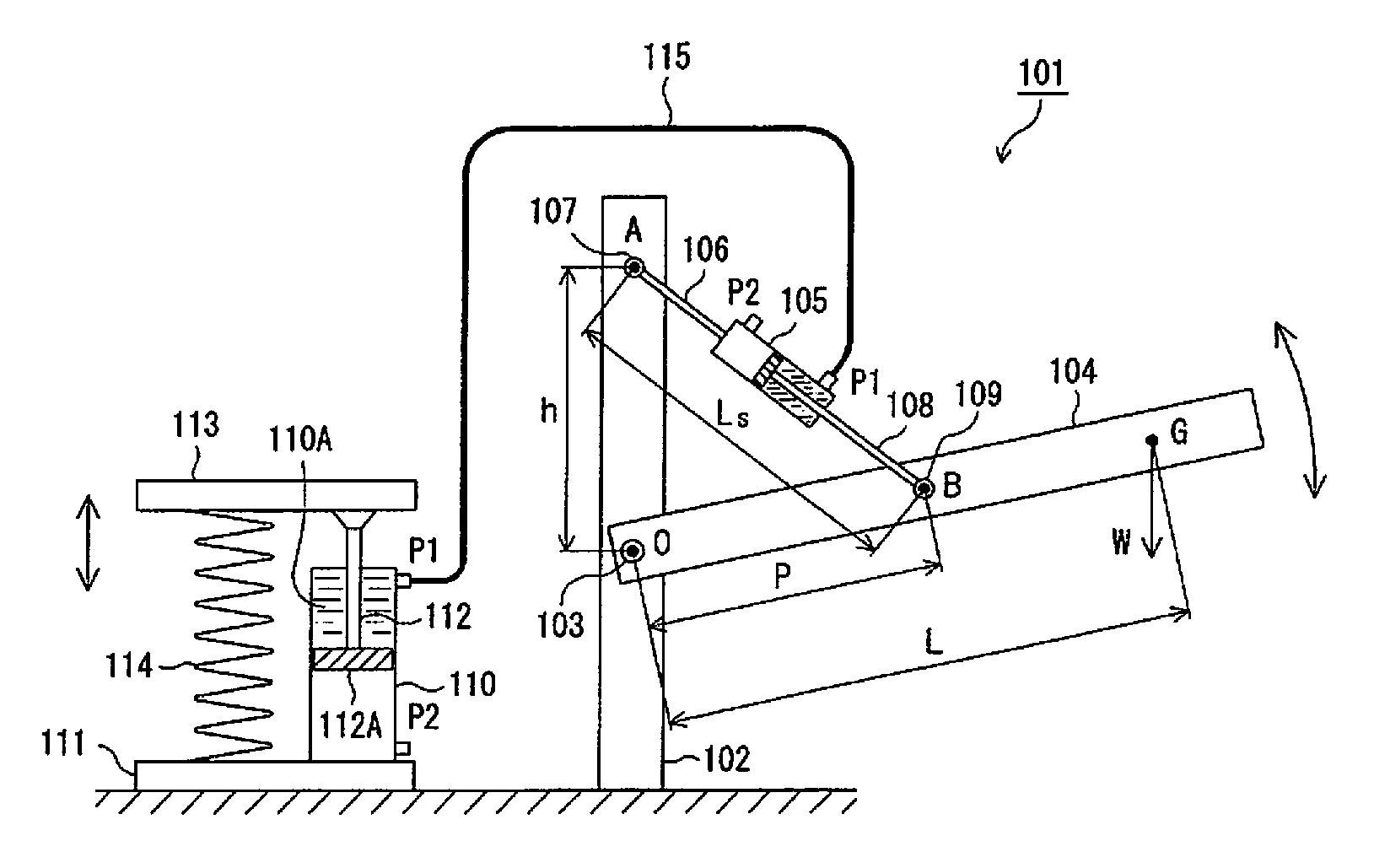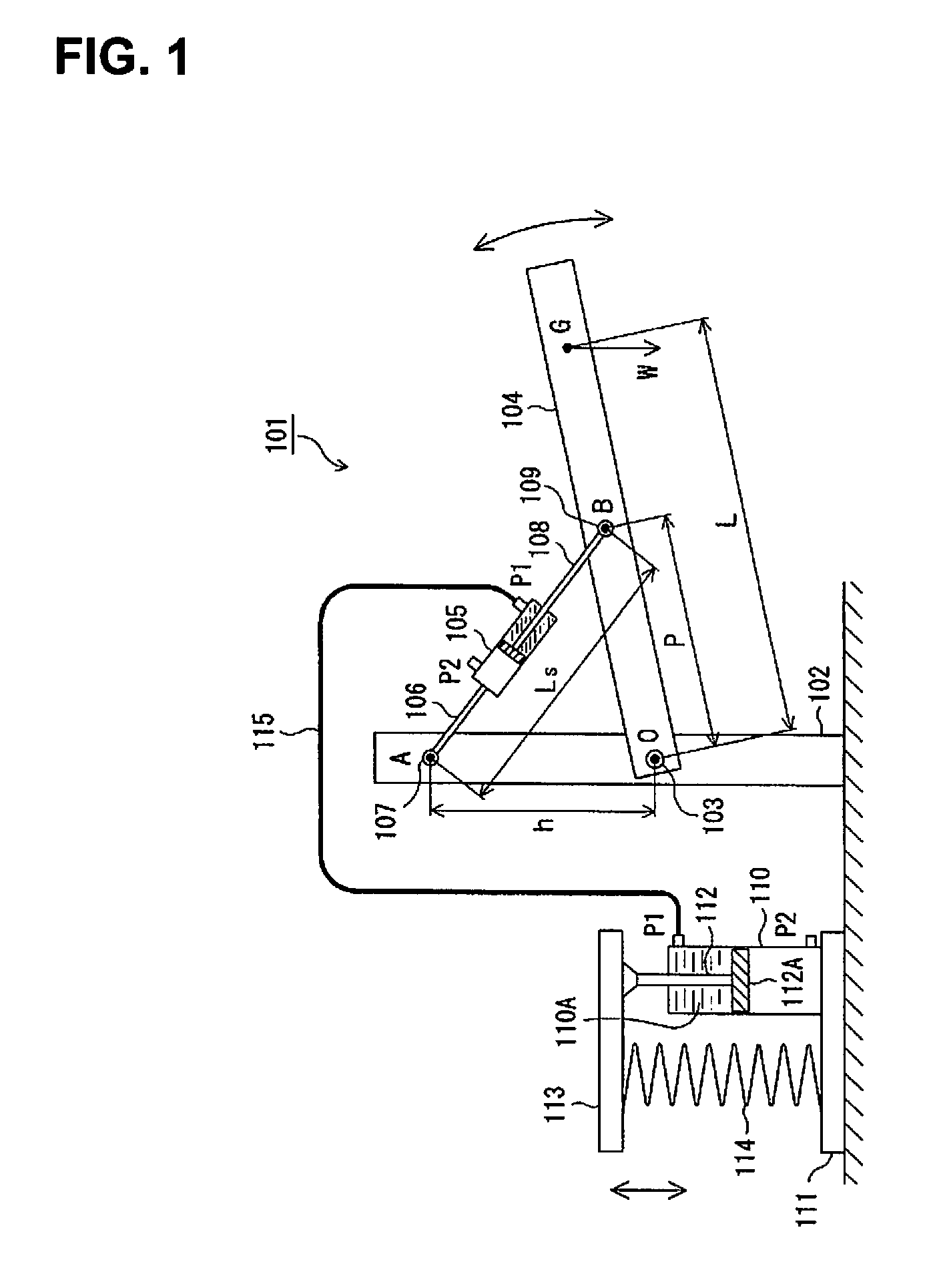Load-compensation device
a load compensation and load technology, applied in mechanical control devices, fluid couplings, servomotors, etc., can solve the problems of wire breaking, deviation in the geometric relationship of various elements, and inability to fully compensate loads, etc., to achieve large degree of design freedom, wide range of weights, and large degree of freedom
- Summary
- Abstract
- Description
- Claims
- Application Information
AI Technical Summary
Benefits of technology
Problems solved by technology
Method used
Image
Examples
exemplary embodiment 1
[0048]FIG. 1 is a schematic diagram of Exemplary Embodiment 1 of the load compensation device according to the present invention; in this figure, a load compensation device 101 comprises a supporting body 102 which is secured to a floor surface. A working arm 104 is supported on the supporting body 102 by means of a horizontal shaft 103 (first pivot-mounting part) in such a way as to be able to pivot about said shaft 103.
[0049]Furthermore, at a point A which is a position lying a distance h vertically above the center O of the shaft 103 of the supporting body 102, an actuator cylinder 105 is pivotably supported by a shaft 107 (second pivot-mounting part) parallel to the shaft 103, with the interposition of a linking rod 106 which is fixed to the head side of the actuator cylinder 105.
[0050]As shown in FIG. 2, a piston 108A provided at one end of a piston rod 108 is slidably inserted inside a cylinder chamber 105A of the actuator cylinder 105. Furthermore, ports P1 and P2 for providi...
exemplary embodiment 2
[0069]FIG. 3 is a schematic diagram of Exemplary Embodiment 2 of the load compensation device according to the present invention; in the load compensation device 101A shown in this figure, the outer peripheral surface at the end of an actuator cylinder 105′ on the piston rod 108′ side is pivotably supported on the supporting body 102 by a shaft 107′ (second pivot-mounting part), and elements in this figure having the same number as in FIG. 1 constitute substantially the same elements as in the load compensation device 101 described above.
[0070]The load compensation device 101A shown in FIG. 3 operates under the same load compensation principle as the load compensation device 101 described above, but the end position of the actuator cylinder 105′ on the rod side is rotatably supported on the supporting body 102 by the shaft 107′, and as a result it is possible to lengthen the stroke of the piston rod 108′, which has the advantage of increasing the range of pivoting of the working arm...
exemplary embodiment 3
[0071]In the load compensation device 1013 shown in FIG. 4, driving working fluid is supplied to the port P2 on the head side of the compensation cylinder 110 and the port P2 on the head side of the actuator cylinder 105′ in the load compensation device 101A described above, or a pair of driving conduits 116A, 116B for discharge are further added; the other elements have substantially the same configuration as in the load compensation device 101A shown in FIG. 3.
[0072]In the load compensation device 101B, the driving conduits 116A, 116B are connected to a driving fluid circuit which is not depicted. A known hydraulic circuit or the like comprising a hydraulic pump and a directional switching valve etc. is used as the driving fluid circuit, for example.
[0073]In the device in this exemplary embodiment, the piston 112A of the compensation cylinder 110 is pushed down when working fluid is supplied from one of the driving conduits 116A to the compensation cylinder 110 while the load torq...
PUM
 Login to View More
Login to View More Abstract
Description
Claims
Application Information
 Login to View More
Login to View More - R&D
- Intellectual Property
- Life Sciences
- Materials
- Tech Scout
- Unparalleled Data Quality
- Higher Quality Content
- 60% Fewer Hallucinations
Browse by: Latest US Patents, China's latest patents, Technical Efficacy Thesaurus, Application Domain, Technology Topic, Popular Technical Reports.
© 2025 PatSnap. All rights reserved.Legal|Privacy policy|Modern Slavery Act Transparency Statement|Sitemap|About US| Contact US: help@patsnap.com



